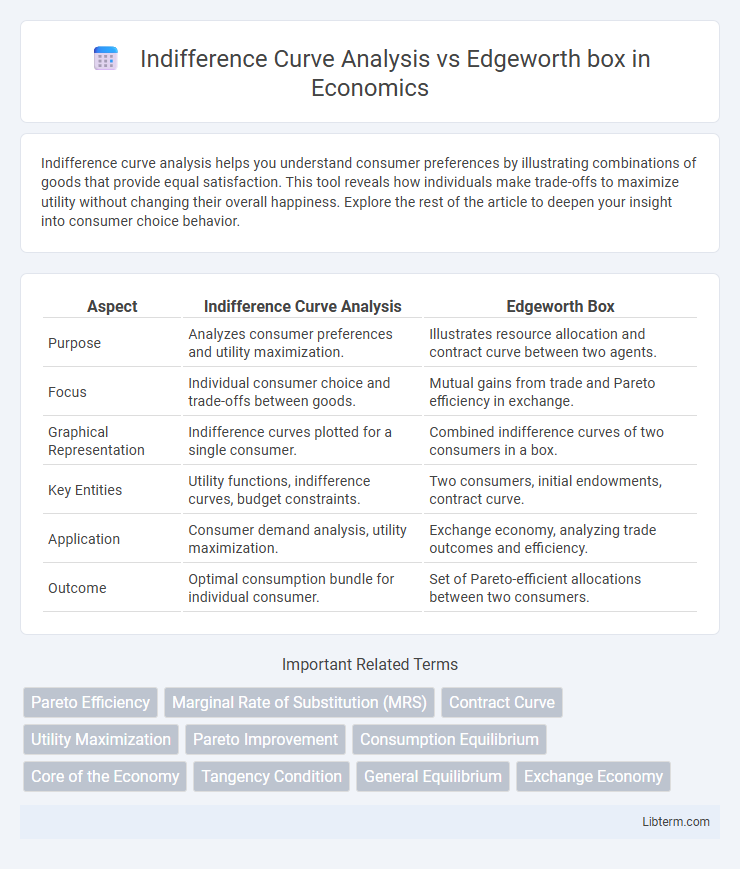Indifference curve analysis helps you understand consumer preferences by illustrating combinations of goods that provide equal satisfaction. This tool reveals how individuals make trade-offs to maximize utility without changing their overall happiness. Explore the rest of the article to deepen your insight into consumer choice behavior.
Table of Comparison
| Aspect | Indifference Curve Analysis | Edgeworth Box |
|---|---|---|
| Purpose | Analyzes consumer preferences and utility maximization. | Illustrates resource allocation and contract curve between two agents. |
| Focus | Individual consumer choice and trade-offs between goods. | Mutual gains from trade and Pareto efficiency in exchange. |
| Graphical Representation | Indifference curves plotted for a single consumer. | Combined indifference curves of two consumers in a box. |
| Key Entities | Utility functions, indifference curves, budget constraints. | Two consumers, initial endowments, contract curve. |
| Application | Consumer demand analysis, utility maximization. | Exchange economy, analyzing trade outcomes and efficiency. |
| Outcome | Optimal consumption bundle for individual consumer. | Set of Pareto-efficient allocations between two consumers. |
Introduction to Indifference Curve Analysis
Indifference Curve Analysis examines consumer preferences by mapping combinations of two goods that provide equal satisfaction, highlighting how choices shift with changes in budget or prices. The analysis uses indifference curves to illustrate marginal rates of substitution, revealing how consumers trade off one good for another to maintain utility. This foundational concept contrasts with the Edgeworth box, which extends to analyze mutual gains from trade and resource allocation between two agents.
Overview of the Edgeworth Box
The Edgeworth box is a graphical representation used to analyze the distribution of resources between two individuals, illustrating all possible allocations and their corresponding utility levels. It combines consumers' indifference curves within a single diagram, allowing identification of efficient trades and equilibrium points where both parties achieve optimal utility. This tool is crucial in general equilibrium theory, providing insights into Pareto efficiency and contract curves beyond the individual-focused indifference curve analysis.
Fundamental Assumptions in Both Models
Indifference Curve Analysis assumes consumers have complete and transitive preferences, allowing for consistent ranking of bundles based on utility, with convex and continuous preferences ensuring diminishing marginal rates of substitution. The Edgeworth Box model builds on similar assumptions but focuses on two individuals' allocations, emphasizing the feasibility of trade and Pareto efficiency within a fixed total endowment. Both models rely on well-behaved preferences and perfect divisibility of goods to analyze optimal consumption and exchange outcomes in microeconomic theory.
Comparative Analysis: Utility Representation
Indifference curve analysis represents individual preferences through continuous, convex curves illustrating combinations of goods providing equal utility, enabling precise measurement of marginal rates of substitution. The Edgeworth box expands this concept to two consumers, graphically depicting their preference relations and potential gains from trade by overlapping individual indifference curves within a fixed resource framework. Comparative analysis reveals that while indifference curves focus on single-agent utility representation, the Edgeworth box integrates multiple utility functions to analyze equilibrium and efficiency in exchange economies.
The Role of Consumer Preferences
Indifference Curve Analysis illustrates consumer preferences through a single individual's trade-offs between goods, reflecting varying utility levels along the curve. The Edgeworth Box extends this by representing two consumers' preferences simultaneously, facilitating the analysis of potential mutual gains from trade and Pareto efficiency. Together, these models highlight how individual and joint consumer preferences determine equilibrium allocations in microeconomic theory.
Application to Exchange and Trade
Indifference Curve Analysis provides a graphical representation of consumer preferences and helps identify optimal consumption bundles through utility maximization, facilitating the understanding of individual choices in exchange. The Edgeworth box extends this by illustrating the allocation of resources between two agents, showing how trade leads to mutually beneficial outcomes and equilibrium through contract curves. Combined, these tools model the dynamics of exchange, highlighting Pareto efficiency and the gains from voluntary trade in economic analysis.
Visualization and Interpretation of Equilibrium
Indifference curve analysis visualizes consumer preferences by plotting curves representing combinations of goods that yield equal satisfaction, with equilibrium found where a budget constraint is tangent to the highest attainable indifference curve. The Edgeworth box expands this visualization to two consumers, illustrating all possible allocations of two goods within a fixed total endowment, and equilibrium is identified at points where their indifference curves are tangent, indicating Pareto efficiency. This comparative graphical approach highlights individual utility maximization in indifference curves versus joint optimization and trade-offs between consumers in the Edgeworth box.
Strengths and Limitations of Indifference Curves
Indifference curve analysis excels in illustrating consumer preferences and trade-offs between two goods, providing a clear visualization of utility maximization and marginal rates of substitution. It simplifies individual decision-making processes but assumes well-behaved preferences and perfect divisibility of goods, which may not hold true in real-world scenarios. However, indifference curves do not capture interactions between multiple agents or the allocation of resources, limitations effectively addressed by the Edgeworth box framework in general equilibrium analysis.
Advantages and Drawbacks of the Edgeworth Box
The Edgeworth box provides a clear graphical representation of the distribution of resources between two agents, facilitating the analysis of Pareto efficiency and contract curves in exchange and production economies. Its advantage lies in illustrating mutual gains from trade and potential equilibrium allocations in a two-agent, two-good framework. However, the Edgeworth box is limited by its assumption of only two agents and two goods, making it less applicable for complex, multi-agent or multi-good markets compared to the more flexible indifference curve analysis.
Conclusion: Choosing Between Indifference Curves and the Edgeworth Box
Indifference curve analysis offers detailed insights into individual consumer preferences and utility maximization, making it ideal for studying single-agent decision-making. The Edgeworth box complements this by illustrating mutual gains from trade and efficient resource allocation between two agents. Selecting between these tools depends on whether the focus is on individual choice optimization or on understanding bilateral exchange and Pareto efficiency in allocation.
Indifference Curve Analysis Infographic

 libterm.com
libterm.com